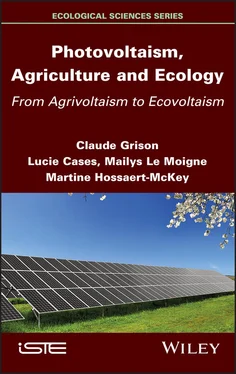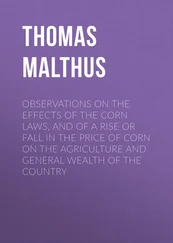7 Appendix 3Figure A3.1. Gallic acid
1 Chapter 1 Table 1.1. Different technologies of photovoltaic cells Table 1.2. Greenhouse gas emissions by form of electricity generation, average v... Table 1.3. Maximum emissions of sulfur dioxide, nitrogen oxides, non-volatile or...
2 Chapter 2Table 2.1. Schematic balance between the advantages and disadvantages of agrivol...
3 Chapter 3Table 3.1. Structure of the lasagna installed under the solar panels in Boissièr...Table 3.2. Flowering period of honey plants. For a color version of this table, ...Table 3.3. Nectar and pollen quality of selected honey plants Table 3.4. Identification of insects larger than 3 mm Table 3.5. Different laws concerning PNPPs
4 Appendix 3Table A3.1. Anthraquinones present in Rheum rhabarbarum Table A3.2. Main stilbenes present in Rheum rhabarbarum Table A3.3. Flavonoids present in Rheum rhabarbarum
1 Cover
2 Table of Contents
3 Title Page Series EditorFrançoise Gaill
4 Copyright First published 2021 in Great Britain and the United States by ISTE Ltd and John Wiley & Sons, Inc. Apart from any fair dealing for the purposes of research or private study, or criticism or review, as permitted under the Copyright, Designs and Patents Act 1988, this publication may only be reproduced, stored or transmitted, in any form or by any means, with the prior permission in writing of the publishers, or in the case of reprographic reproduction in accordance with the terms and licenses issued by the CLA. Enquiries concerning reproduction outside these terms should be sent to the publishers at the undermentioned address: ISTE Ltd 27-37 St George’s Road London SW19 4EU UK www.iste.co.uk John Wiley & Sons, Inc. 111 River Street Hoboken, NJ 07030 USA www.wiley.com © ISTE Ltd 2021 The rights of Claude Grison, Lucie Cases, Mailys Le Moigne and Martine Hossaert-McKey to be identified as the authors of this work have been asserted by them in accordance with the Copyright, Designs and Patents Act 1988. Library of Congress Control Number: 2021942790 British Library Cataloguing-in-Publication Data A CIP record for this book is available from the British Library ISBN 978-1-78630-720-0
5 Foreword by Yvon Le Maho
6 Foreword by Thomas Lesueur
7 Introduction
8 Begin Reading
9 Appendices
10 Appendix 1 Secondary Metabolites and Defense Molecules of Eagle Fern
11 Appendix 2 Secondary Metabolites and Defense Molecules of Alder Buckthorn
12 Appendix 3 Secondary Metabolites and Defense Molecules of Rhubarb
13 References
14 Index
15 End User License Agreement
1 v
2 iii
3 iv
4 ix
5 x
6 xi
7 xiii
8 xiv
9 xv
10 xvi
11 xvii
12 xviii
13 xix
14 1
15 2
16 3
17 4
18 5
19 6
20 7
21 8
22 9
23 10
24 11
25 12
26 13
27 14
28 15
29 16
30 17
31 18
32 19
33 20
34 21
35 22
36 23
37 24
38 25
39 26
40 27
41 28
42 29
43 30
44 31
45 32
46 33
47 34
48 35
49 36
50 37
51 38
52 39
53 40
54 41
55 42
56 43
57 44
58 45
59 46
60 47
61 48
62 49
63 50
64 51
65 52
66 53
67 54
68 55
69 56
70 57
71 58
72 59
73 60
74 61
75 63
76 64
77 65
78 66
79 67
80 68
81 69
82 70
83 71
84 72
85 73
86 74
87 75
88 76
89 77
90 78
91 79
92 80
93 81
94 82
95 83
96 84
97 85
98 86
99 87
100 88
101 89
102 90
103 91
104 92
105 93
106 94
107 95
108 96
109 97
110 98
111 99
112 100
113 101
114 103
115 105
116 106
117 107
118 108
119 109
120 110
121 111
122 112
123 113
124 114
125 115
126 116
127 117
128 118
129 119
130 121
131 122
132 123
133 124
134 125
135 126
136 127
137 128
138 129
139 130
140 131
141 132
142 133
143 134
144 135
145 136
146 137
147 139
148 140
149 141
150 142
Series EditorFrançoise Gaill
Photovoltaism, Agriculture and Ecology
From Agrivoltaism to Ecovoltaism
Claude Grison
Lucie Cases
Mailys Le Moigne
Martine Hossaert-McKey

First published 2021 in Great Britain and the United States by ISTE Ltd and John Wiley & Sons, Inc.
Apart from any fair dealing for the purposes of research or private study, or criticism or review, as permitted under the Copyright, Designs and Patents Act 1988, this publication may only be reproduced, stored or transmitted, in any form or by any means, with the prior permission in writing of the publishers, or in the case of reprographic reproduction in accordance with the terms and licenses issued by the CLA. Enquiries concerning reproduction outside these terms should be sent to the publishers at the undermentioned address:
ISTE Ltd
27-37 St George’s Road
London SW19 4EU
UK
www.iste.co.uk
John Wiley & Sons, Inc.
111 River Street
Hoboken, NJ 07030
USA
www.wiley.com
© ISTE Ltd 2021
The rights of Claude Grison, Lucie Cases, Mailys Le Moigne and Martine Hossaert-McKey to be identified as the authors of this work have been asserted by them in accordance with the Copyright, Designs and Patents Act 1988.
Library of Congress Control Number: 2021942790
British Library Cataloguing-in-Publication Data
A CIP record for this book is available from the British Library
ISBN 978-1-78630-720-0
This update by Claude Grison, Lucie Cases, Mailys Le Moigne and Martine Hossaert-McKey on how the development of a renewable energy, photovoltaics, could be part of a real ecological transition meets a real need.
Indeed, in view of the two major environmental issues of our time – the fight against climate change and the reduction of biodiversity – we are faced with what appears to be an abuse of language that hides a real divide. What is it about? In the dominant discourse, climate change is associated with an “ecological catastrophe”. Certainly, according to the most probable scenarios, the announced global warming will eventually result in a significant loss of biodiversity. To avoid such an outcome, this implies that we must fight against climate change.
In fact, the seriousness of this prognosis is largely linked to the fact that climate change will weigh on an already weakened biodiversity. For most of the reduction in biodiversity already observed, more than 80% of the decrease in populations of threatened species, according to a recent WWF study, has nothing to do with climate change. Land artificialization, overexploitation of resources, intensive farming and disturbance are the main causes. It is therefore two parallel actions, both fighting against the human factors of climate change, that is, against the increase of greenhouse gases, and recovering biodiversity, that must be carried out. The indicators of the better health of fauna that followed the recent period of confinement caused by the COVID-19 health crisis have shown something important: the reduction of the disturbance induced by humans towards the animal populations during their period of reproduction has already shown very positive effects… However, the stakes of the fight against the reduction of biodiversity are not only patrimonial but also economic. The crucial importance of pollinating insects is enough to remind us of this.
Читать дальше













